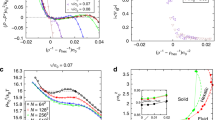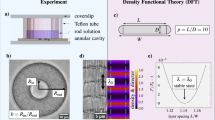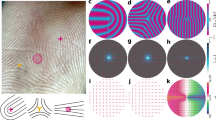Abstract
One of the most remarkable phenomena exhibited by colloidal suspensions of monodisperse rod-like particles is the spontaneous formation of smectic liquid crystals1–5. In these smectic phases, the particles order in periodic layers; on average, the axes of the rods are perpendicular to the layers. Smectics are distinct from crystals in that there is no long-range positional order within the layers. Because the spacing of the smectic layers is of the order of optical wavelengths, white light is separated into colours when scattered, giving rise to beautiful iridescence as in the colour photographs of ref. 2. As early as 1949, Onsager6 showed that nematic ordering may arise from hard-core repulsions between anisometric particles. However, it appears to have been generally accepted in the literature that smectic liquid crystalline ordering demands that attractive forces also operate7. There is nevertheless experimental evidence that smectic ordering does occur in colloidal systems where the particles interact predominantly through repulsive electrostatic interactions. This observation raises the fundamental question of whether smectic ordering can occur in a system of particles with purely repulsive interactions. Inspired by the seminal work of Alder and Wainwright8 on the freezing of a system of hard spheres, we have explored the possibility that smectic ordering occurs in a fluid of hard rod-like particles. Earlier computer simulations on hard parallel spherocylinders9,10 (cylinders with length L and diameter D, capped at each end with hemispheres of the same diameter) indicated that, in this somewhat artificial system, smectic order was indeed possible. Here we present numerical evidence that hard spherocylinders with both translational and orientational freedom can form a thermodynamically stable smectic phase.
This is a preview of subscription content, access via your institution
Access options
Subscribe to this journal
Receive 51 print issues and online access
$199.00 per year
only $3.90 per issue
Buy this article
- Purchase on Springer Link
- Instant access to full article PDF
Prices may be subject to local taxes which are calculated during checkout
Similar content being viewed by others
References
Oster, G. J. gen. Physiol. 33, 445–473 (1950).
Kreibig, U. & Wetter, C. Z. Naturforsch. 35C, 750–762 (1980).
Fraden, S., Hurd, A. J., Meyer, R. B., Cahoon, M. & Caspar, D. L. D. J. Phys. (Paris), Colloq. 46 C3, 85–113 (1985).
Maeda, Y. & Hachisu, S. Colloids and Interfaces 6, 1–16 (1983).
Maeda, Y. & Hachisu, S. Colloids and Interfaces 7, 357–360 (1984).
Onsager, L. Ann. N.Y. Acad. Sci. 51, 627–659 (1949).
Kloczkowski, A. & Stecki, J. Molec. Phys. 55, 689–700 (1985).
Alder, B. J. & Wainwright, T. E. J. Chem. Phys. 27, 1208–1209 (1957).
Stroobants, A. Lekkerkerker, H. N. W. & Frenkel, D. Phys. Rev. Lett. 57, 1452–1455 (1986).
Stroobants, A., Lekkerkerker, H. N. W. & Frenkel, D. Phys. Rev. A36, 2929–2945 (1987).
Frenkel, D. & Mulder, B. M. Molec. Phys. 55, 1171–1192 (1985).
Frenkel, D. J. phys. Chem. (in the press).
Author information
Authors and Affiliations
Rights and permissions
About this article
Cite this article
Frenkel, D., Lekkerkerker, H. & Stroobants, A. Thermodynamic stability of a smectic phase in a system of hard rods. Nature 332, 822–823 (1988). https://doi.org/10.1038/332822a0
Received:
Accepted:
Issue Date:
DOI: https://doi.org/10.1038/332822a0
This article is cited by
-
Rod-shaped microparticles — an overview of synthesis and properties
Colloid and Polymer Science (2023)
-
Splay-bend nematic phases of bent colloidal silica rods induced by polydispersity
Nature Communications (2022)
-
Entropic patchiness drives multi-phase coexistence in discotic colloid–depletant mixtures
Scientific Reports (2017)
-
Entropy-driven formation of chiral nematic phases by computer simulations
Nature Communications (2016)
-
High-Activity Expansion for the Columnar Phase of the Hard Rectangle Gas
Journal of Statistical Physics (2015)
Comments
By submitting a comment you agree to abide by our Terms and Community Guidelines. If you find something abusive or that does not comply with our terms or guidelines please flag it as inappropriate.



